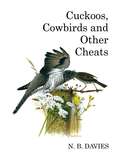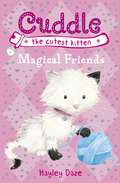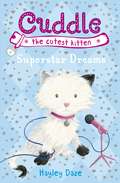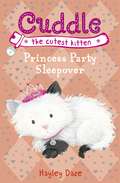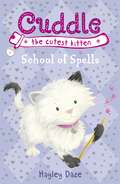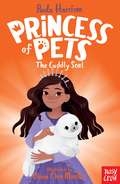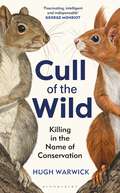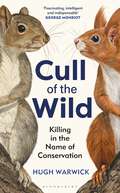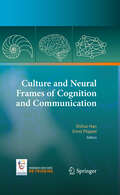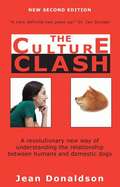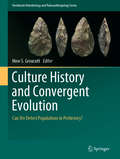- Table View
- List View
Cuckoo: Cheating by Nature (Poyser Natural History Ser.)
by Nick DaviesBeloved as the herald of spring, cuckoos have held a place in our affections for centuries. The oldest song in English celebrates the cuckoo's arrival, telling us that 'Sumer is icumen in'. But for many other birds the cuckoo is a signal of doom, for it is Nature's most notorious cheat. Cuckoos across the world have evolved extraordinary tricks to manipulate other species into raising their young. How do they get away with it?In this enormously engaging book, naturalist and scientist Nick Davies reveals how cuckoos trick their hosts. Using shrewd detective skills and field experiments, he uncovers an evolutionary arms race, in which hosts evolve better defences against cuckoos and cuckoos, in turn, evolve novel forms of trickery. This is a fascinating corner of Darwin's 'entangled bank', where creatures are continually evolving to keep up with changes in their rivals.Lively field drawings by James McCallum, and remarkable photographs, show cuckoos in action: from the female cuckoo laying her beautifully disguised egg, to the cuckoo chick ejecting the host's eggs and young from the nest to ensure it gets the full attention of its foster parents.Cuckoo offers a new insight not only into the secret lives of these extraordinary birds, but also into how cheating evolves and thrives in the natural world.
Cuckoo: Cheating by Nature (Poyser Natural History Ser. #60)
by Nick DaviesA gifted biologist's careful and beguiling study of why cuckoos have got away with tricking other birds into hatching and raising their young for thousands of years. The familiar call of the common cuckoo, "cuck-oo,†? has been a harbinger of spring ever since our ancestors walked out of Africa many thousands of years ago. However, for naturalist and scientist Nick Davies, the call is an invitation to solve an enduring puzzle: how does the cuckoo get away with laying its eggs in the nests of other birds and tricking them into raising young cuckoos rather than their own offspring?Early observers who noticed a little warbler feeding a monstrously large cuckoo chick concluded the cuckoo's lack of parental care was the result of faulty design by the Creator, and that the hosts chose to help the poor cuckoo. These quaint views of bad design and benevolence were banished after Charles Darwin proposed that the cuckoo tricks the hosts in an evolutionary battle, where hosts evolve better defenses against cuckoos and cuckoos, in turn, evolve better trickery to outwit the hosts. For the last three decades, Davies has employed observation and field experiments to unravel the details of this evolutionary "arms race†? between cuckoos and their hosts. Like a detective, Davies and his colleagues studied adult cuckoo behavior, cuckoo egg markings, and cuckoo chick begging calls to discover exactly how cuckoos trick their hosts. For birding and evolution aficionados, The Cuckoo is a lyrical and scientifically satisfying exploration of one of nature's most astonishing and beautiful adaptations.
Cuckoos, Cowbirds and Other Cheats (Poyser Monographs #60)
by Nick DaviesIn this fascinating new book, Nick Davies describes the natural histories of these brood parasites and examines many of the exciting questions they raise about the evolution of cheating and the arms race between parasites and their prey. Brood parasites fill their armory with adaptations including exquisite egg mimicry, rapid laying, ejection of host eggs, murder of host young, chick mimicry and manipulative begging behavior: ploys shown by recent research to have evolved in response to host defense behavior or through competition among the parasites themselves. While many host species appear defenseless, accepting parasite eggs quite unlike their own, many are more discriminating against odd-looking eggs and some have evolved the ability to discriminate against odd-looking chicks as well. How is this arms race conducted? Will defenseless hosts develop defenses in time, or are there constraints which limit the evolution and perfection of host defenses? And why are so few species obliged only to lay eggs in host nests? Have host defenses limited the success of brood parasitism, or is it in fact much more common than we suspect, but occurring mainly when birds parasitize the nest of their own kind? All of these puzzles are examined in descriptions of the natural history of each of the groups of parasites in turn. Here is a book with wide appeal, both to amateur naturalists fascinated by this most singular and macabre of behaviors and by ornithologists and ecologists interested in the evolution of ecology and behavior. The story takes us from the classic field work earlier this century by pioneer ornithologists such as Edgar Chance, Stuart Baker, Herbert Friedmann and others, through to the recent experimental field work and molecular techniques of today's leading scientists. We visit brood parasites in Europe, Asia, Japan, Africa, Australasia, and North and South America, to look at some of the worlds most interesting birds and some of biology's most interesting questions, many of which still beg answers from ornithologists in the future. Brilliant illustrations by David Quinn illuminate the species discussed, showing many behaviors never before illustrated and conveying the thrill of watching these astonishing birds in the wild.
Cuckoos, Cowbirds and Other Cheats (Poyser Monographs)
by Nick Davies David QuinnIn this fascinating new book, Nick Davies describes the natural histories of these brood parasites and examines many of the exciting questions they raise about the evolution of cheating and the arms race between parasites and their prey. Brood parasites fill their armory with adaptations including exquisite egg mimicry, rapid laying, ejection of host eggs, murder of host young, chick mimicry and manipulative begging behavior: ploys shown by recent research to have evolved in response to host defense behavior or through competition among the parasites themselves. While many host species appear defenseless, accepting parasite eggs quite unlike their own, many are more discriminating against odd-looking eggs and some have evolved the ability to discriminate against odd-looking chicks as well. How is this arms race conducted? Will defenseless hosts develop defenses in time, or are there constraints which limit the evolution and perfection of host defenses? And why are so few species obliged only to lay eggs in host nests? Have host defenses limited the success of brood parasitism, or is it in fact much more common than we suspect, but occurring mainly when birds parasitize the nest of their own kind? All of these puzzles are examined in descriptions of the natural history of each of the groups of parasites in turn. Here is a book with wide appeal, both to amateur naturalists fascinated by this most singular and macabre of behaviors and by ornithologists and ecologists interested in the evolution of ecology and behavior. The story takes us from the classic field work earlier this century by pioneer ornithologists such as Edgar Chance, Stuart Baker, Herbert Friedmann and others, through to the recent experimental field work and molecular techniques of today's leading scientists. We visit brood parasites in Europe, Asia, Japan, Africa, Australasia, and North and South America, to look at some of the worlds most interesting birds and some of biology's most interesting questions, many of which still beg answers from ornithologists in the future. Brilliant illustrations by David Quinn illuminate the species discussed, showing many behaviors never before illustrated and conveying the thrill of watching these astonishing birds in the wild.
Cuckoos of the World (Helm Identification Guides)
by Johannes Erritzøe Clive F. Mann Frederik Brammer Richard A. FullerThis authoritative handbook, part of the Helm Identification Guides series, looks in detail at the world's cuckoos, couas and coucals - the family Cuculidae. Famed as brood-parasites of other birds, the cuckoos include a diverse range of species, from the roadrunners of North America to the spectacular malkohas of southern Asia. This book discusses the biology and identification of these birds on a species-by-species basis, bringing together the very latest research with accurate range maps, more than 600 stunning colour photographs that illuminate age and racial plumage differences, and 36 superb plates by a team of internationally renowned artists.
Cuddle the Cutest Kitten: Book 1
by Hayley DazeWhen Cuddle the kitten comes to play, magic is never far away!When Cuddle the cutest kitten appears, Olivia and Grace are in for a big adventure! With a sparkle of kitten magic, the girls find themselves at an amazing pyramid.Princess Beset has lost her kitten inside the pyramid maze. With Cuddle's help, can the girls save the day?
Cuddle the Cutest Kitten: Book 2
by Hayley DazeWhen Cuddle the kitten comes to play, magic is never far away!When Cuddle the cutest kitten appears, Olivia and Grace are in for a big adventure! With a sparkle of kitten magic, the girls find themselves at a TV talent show.It's Chloe's turn to audition but she can't do it without her lucky charm. Will Cuddle and the girls help save Chloe's dreams?
Cuddle the Cutest Kitten: Book 3
by Hayley DazeWhen Cuddle the kitten comes to play, magic is never far away!When Cuddle the cutest kitten appears, Olivia and Grace are in for a big adventure! With a sparkle of kitten magic, the girls find themselves inside a wonderful royal palace.Princess Victoria is supposed to be at a royal ball but she'd rather have a sleepover. Can Cuddle and the girls convince the Princess she could do both and have twice the fun?
Cuddle the Cutest Kitten: Book 4
by Hayley DazeWhen Cuddle the kitten comes to play, magic is never far away!When Cuddle the cutest kitten appears, Olivia and Grace are in for a big adventure! With a sparkle of kitten magic, the girls find themselves in an enchanted school. The littlest unicorn at the school is lonely. Can Cuddle and the girls help him to make new friends?
The Cuddly Seal (Princess of Pets)
by Paula HarrisonRuby Palace is no place for pets! But Princess Bea won't let royal rules stop her from helping animals in need. While exploring Silver Rock Bay, Bea comes across a little seal pup that has been left alone on some rocks. Bea and her friend Keira are determined to help, but with a big storm coming, can they reunite the baby seal with its mother?With a shiny foil cover and beautifully illustrated throughout by Olivia Chin Mueller, this is the perfect book for animal-mad young readers aged 6+. Look out for more of Princess Bea's adventures!The Naughty KittenThe Lost PuppyThe Snowy ReindeerThe Lonely Pony
Cull of the Wild: Killing in the Name of Conservation
by Hugh WarwickInvestigating the ethical and practical challenges of one of the greatest threats to biodiversity: invasive species.Across the world, invasive species pose a danger to ecosystems. The UN Convention on Biological Diversity ranks them as a major threat to biodiversity on par with habitat loss, climate change and pollution.Tackling this isn't easy, and no one knows this better than Hugh Warwick, a conservationist who loathes the idea of killing, harming or even eating animals. Yet as an ecologist, he is acutely aware of the need, at times, to kill invasive species whose presence harms the wider environment.Hugh explores the complex history of species control, revealing the global movement of species and the impacts of their presence. Combining scientific theory with gentle humour in his signature style, he explains the issues conservationists face to control non-native animals and protect native species – including grey and red squirrels on Anglesey, ravens and tortoises in the Mojave Desert, cane toads in Australia and the smooth-billed ani on the Galapagos – and describes cases like Pablo Escobar's cocaine hippos and the Burmese python pet trade.Taking a balanced and open approach to this emotive subject, Hugh speaks to experts on all sides of the debate. How do we protect endangered native species? Which species do we prioritise? And how do we reckon with the ethics of killing anything in the name of conservation?
Cull of the Wild: Killing in the Name of Conservation
by Hugh WarwickInvestigating the ethical and practical challenges of one of the greatest threats to biodiversity: invasive species.Across the world, invasive species pose a danger to ecosystems. The UN Convention on Biological Diversity ranks them as a major threat to biodiversity on par with habitat loss, climate change and pollution.Tackling this isn't easy, and no one knows this better than Hugh Warwick, a conservationist who loathes the idea of killing, harming or even eating animals. Yet as an ecologist, he is acutely aware of the need, at times, to kill invasive species whose presence harms the wider environment.Hugh explores the complex history of species control, revealing the global movement of species and the impacts of their presence. Combining scientific theory with gentle humour in his signature style, he explains the issues conservationists face to control non-native animals and protect native species – including grey and red squirrels on Anglesey, ravens and tortoises in the Mojave Desert, cane toads in Australia and the smooth-billed ani on the Galapagos – and describes cases like Pablo Escobar's cocaine hippos and the Burmese python pet trade.Taking a balanced and open approach to this emotive subject, Hugh speaks to experts on all sides of the debate. How do we protect endangered native species? Which species do we prioritise? And how do we reckon with the ethics of killing anything in the name of conservation?
The Cultural Lives of Whales and Dolphins
by Hal Whitehead Luke RendellIn the songs and bubble feeding of humpback whales; in young killer whales learning to knock a seal from an ice floe in the same way their mother does; and in the use of sea sponges by the dolphins of Shark Bay, Australia, to protect their beaks while foraging for fish, we find clear examples of the transmission of information among cetaceans. Just as human cultures pass on languages and turns of phrase, tastes in food (and in how it is acquired), and modes of dress, could whales and dolphins have developed a culture of their very own? Unequivocally: yes. In The Cultural Lives of Whales and Dolphins, cetacean biologists Hal Whitehead, who has spent much of his life on the ocean trying to understand whales, and Luke Rendell, whose research focuses on the evolution of social learning, open an astounding porthole onto the fascinating culture beneath the waves. As Whitehead and Rendell show, cetacean culture and its transmission are shaped by a blend of adaptations, innate sociality, and the unique environment in which whales and dolphins live: a watery world in which a hundred-and-fifty-ton blue whale can move with utter grace, and where the vertical expanse is as vital, and almost as vast, as the horizontal. Drawing on their own research as well as a scientific literature as immense as the sea—including evolutionary biology, animal behavior, ecology, anthropology, psychology, and neuroscience—Whitehead and Rendell dive into realms both humbling and enlightening as they seek to define what cetacean culture is, why it exists, and what it means for the future of whales and dolphins. And, ultimately, what it means for our future, as well.
The Cultural Lives of Whales and Dolphins
by Hal Whitehead Luke RendellIn the songs and bubble feeding of humpback whales; in young killer whales learning to knock a seal from an ice floe in the same way their mother does; and in the use of sea sponges by the dolphins of Shark Bay, Australia, to protect their beaks while foraging for fish, we find clear examples of the transmission of information among cetaceans. Just as human cultures pass on languages and turns of phrase, tastes in food (and in how it is acquired), and modes of dress, could whales and dolphins have developed a culture of their very own? Unequivocally: yes. In The Cultural Lives of Whales and Dolphins, cetacean biologists Hal Whitehead, who has spent much of his life on the ocean trying to understand whales, and Luke Rendell, whose research focuses on the evolution of social learning, open an astounding porthole onto the fascinating culture beneath the waves. As Whitehead and Rendell show, cetacean culture and its transmission are shaped by a blend of adaptations, innate sociality, and the unique environment in which whales and dolphins live: a watery world in which a hundred-and-fifty-ton blue whale can move with utter grace, and where the vertical expanse is as vital, and almost as vast, as the horizontal. Drawing on their own research as well as a scientific literature as immense as the sea—including evolutionary biology, animal behavior, ecology, anthropology, psychology, and neuroscience—Whitehead and Rendell dive into realms both humbling and enlightening as they seek to define what cetacean culture is, why it exists, and what it means for the future of whales and dolphins. And, ultimately, what it means for our future, as well.
The Cultural Lives of Whales and Dolphins
by Hal Whitehead Luke RendellIn the songs and bubble feeding of humpback whales; in young killer whales learning to knock a seal from an ice floe in the same way their mother does; and in the use of sea sponges by the dolphins of Shark Bay, Australia, to protect their beaks while foraging for fish, we find clear examples of the transmission of information among cetaceans. Just as human cultures pass on languages and turns of phrase, tastes in food (and in how it is acquired), and modes of dress, could whales and dolphins have developed a culture of their very own? Unequivocally: yes. In The Cultural Lives of Whales and Dolphins, cetacean biologists Hal Whitehead, who has spent much of his life on the ocean trying to understand whales, and Luke Rendell, whose research focuses on the evolution of social learning, open an astounding porthole onto the fascinating culture beneath the waves. As Whitehead and Rendell show, cetacean culture and its transmission are shaped by a blend of adaptations, innate sociality, and the unique environment in which whales and dolphins live: a watery world in which a hundred-and-fifty-ton blue whale can move with utter grace, and where the vertical expanse is as vital, and almost as vast, as the horizontal. Drawing on their own research as well as a scientific literature as immense as the sea—including evolutionary biology, animal behavior, ecology, anthropology, psychology, and neuroscience—Whitehead and Rendell dive into realms both humbling and enlightening as they seek to define what cetacean culture is, why it exists, and what it means for the future of whales and dolphins. And, ultimately, what it means for our future, as well.
The Cultural Lives of Whales and Dolphins
by Hal Whitehead Luke RendellIn the songs and bubble feeding of humpback whales; in young killer whales learning to knock a seal from an ice floe in the same way their mother does; and in the use of sea sponges by the dolphins of Shark Bay, Australia, to protect their beaks while foraging for fish, we find clear examples of the transmission of information among cetaceans. Just as human cultures pass on languages and turns of phrase, tastes in food (and in how it is acquired), and modes of dress, could whales and dolphins have developed a culture of their very own? Unequivocally: yes. In The Cultural Lives of Whales and Dolphins, cetacean biologists Hal Whitehead, who has spent much of his life on the ocean trying to understand whales, and Luke Rendell, whose research focuses on the evolution of social learning, open an astounding porthole onto the fascinating culture beneath the waves. As Whitehead and Rendell show, cetacean culture and its transmission are shaped by a blend of adaptations, innate sociality, and the unique environment in which whales and dolphins live: a watery world in which a hundred-and-fifty-ton blue whale can move with utter grace, and where the vertical expanse is as vital, and almost as vast, as the horizontal. Drawing on their own research as well as a scientific literature as immense as the sea—including evolutionary biology, animal behavior, ecology, anthropology, psychology, and neuroscience—Whitehead and Rendell dive into realms both humbling and enlightening as they seek to define what cetacean culture is, why it exists, and what it means for the future of whales and dolphins. And, ultimately, what it means for our future, as well.
The Cultural Lives of Whales and Dolphins
by Hal Whitehead Luke RendellIn the songs and bubble feeding of humpback whales; in young killer whales learning to knock a seal from an ice floe in the same way their mother does; and in the use of sea sponges by the dolphins of Shark Bay, Australia, to protect their beaks while foraging for fish, we find clear examples of the transmission of information among cetaceans. Just as human cultures pass on languages and turns of phrase, tastes in food (and in how it is acquired), and modes of dress, could whales and dolphins have developed a culture of their very own? Unequivocally: yes. In The Cultural Lives of Whales and Dolphins, cetacean biologists Hal Whitehead, who has spent much of his life on the ocean trying to understand whales, and Luke Rendell, whose research focuses on the evolution of social learning, open an astounding porthole onto the fascinating culture beneath the waves. As Whitehead and Rendell show, cetacean culture and its transmission are shaped by a blend of adaptations, innate sociality, and the unique environment in which whales and dolphins live: a watery world in which a hundred-and-fifty-ton blue whale can move with utter grace, and where the vertical expanse is as vital, and almost as vast, as the horizontal. Drawing on their own research as well as a scientific literature as immense as the sea—including evolutionary biology, animal behavior, ecology, anthropology, psychology, and neuroscience—Whitehead and Rendell dive into realms both humbling and enlightening as they seek to define what cetacean culture is, why it exists, and what it means for the future of whales and dolphins. And, ultimately, what it means for our future, as well.
The Cultural Lives of Whales and Dolphins
by Hal Whitehead Luke RendellIn the songs and bubble feeding of humpback whales; in young killer whales learning to knock a seal from an ice floe in the same way their mother does; and in the use of sea sponges by the dolphins of Shark Bay, Australia, to protect their beaks while foraging for fish, we find clear examples of the transmission of information among cetaceans. Just as human cultures pass on languages and turns of phrase, tastes in food (and in how it is acquired), and modes of dress, could whales and dolphins have developed a culture of their very own? Unequivocally: yes. In The Cultural Lives of Whales and Dolphins, cetacean biologists Hal Whitehead, who has spent much of his life on the ocean trying to understand whales, and Luke Rendell, whose research focuses on the evolution of social learning, open an astounding porthole onto the fascinating culture beneath the waves. As Whitehead and Rendell show, cetacean culture and its transmission are shaped by a blend of adaptations, innate sociality, and the unique environment in which whales and dolphins live: a watery world in which a hundred-and-fifty-ton blue whale can move with utter grace, and where the vertical expanse is as vital, and almost as vast, as the horizontal. Drawing on their own research as well as a scientific literature as immense as the sea—including evolutionary biology, animal behavior, ecology, anthropology, psychology, and neuroscience—Whitehead and Rendell dive into realms both humbling and enlightening as they seek to define what cetacean culture is, why it exists, and what it means for the future of whales and dolphins. And, ultimately, what it means for our future, as well.
Culture and Neural Frames of Cognition and Communication (On Thinking)
by Shihui Han and Ernst PöppelShihui Han and Ernst PöppelCultural neuroscience combines brain imaging techniques such as functional magnetic resonance imaging and event-related brain potentials with methods of social and cultural psychology to investigate whether and how cultures influence the neural mechanisms of perception, attention, emotion, social cognition, and other human cognitive processes. The findings of cultural neuroscience studies improve our understanding of the relation between human brain function and sociocultural contexts and help to reframe the “big question” of nature versus nurture. This book is organized so that two chapters provide general views of the relation between biological evolution, cultural evolution and recent cultural neuroscience studies, while other chapters focus on several aspects of human cognition that have been shown to be strongly influenced by sociocultural factors such as self-concept representation, language processes, emotion, time perception, and decision-making. The main goal of this work is to address how thinking actually takes place and how the underlying neural mechanisms are affected by culture and identity.
The Culture Clash
by Jean DonaldsonThe book that has shaped modern dog training and ownership with its unique and scientifically sound recognition of the "cultural" differences between dogs and humans.
Culture History and Convergent Evolution: Can We Detect Populations in Prehistory? (Vertebrate Paleobiology and Paleoanthropology)
by Huw S. GroucuttThis volume brings together diverse contributions from leading archaeologists and paleoanthropologists, covering various spatial and temporal periods to distinguish convergent evolution from cultural transmission in order to see if we can discover ancient human populations. With a focus on lithic technology, the book analyzes ancient materials and cultures to systematically explore the theoretical and physical aspects of culture, convergence, and populations in human evolution and prehistory. The book will be of interest to academics, students and researchers in archaeology, paleoanthropology, genetics, and paleontology. The book begins by addressing early prehistory, discussing the convergent evolution of behaviors and the diverse ecological conditions driving the success of different evolutionary paths. Chapters discuss these topics and technology in the context of the Lower Paleolithic/Earlier Stone age and Middle Paleolithic/Middle Stone Age. The book then moves towards a focus on the prehistory of our species over the last 40,000 years. Topics covered include the human evolutionary and dispersal consequences of the Middle-Upper Paleolithic Transition in Western Eurasia. Readers will also learn about the cultural convergences, and divergences, that occurred during the Terminal Pleistocene and Holocene, such as the budding of human societies in the Americas. The book concludes by integrating these various perspectives and theories, and explores different methods of analysis to link technological developments and cultural convergence.
Cumulative Effects in Wildlife Management: Impact Mitigation
by Paul R. Krausman Lisa K. HarrisAs humans continue to encroach on wildlands, quality and quantity of wildlife habitat decreases before our eyes. A housing development here, a shopping mall there, a few more trees cut here, another road put in there, each of these diminishes available habitat. Unless the cumulative effects of multiple simultaneous development projects are recogniz
Cunningham's Textbook of Veterinary Physiology - E-Book: Cunningham's Textbook of Veterinary Physiology - E-Book
by T Bradley G. KleinUnderstanding the normal functions of the body is essential for successful veterinary practice and for understanding the mechanisms of disease. The 5th edition of Textbook of Veterinary Physiology approaches this vast subject in a practical, user-friendly way that helps you understand how key concepts relate to clinical practice. From cell physiology to body system function to homeostasis and immune function, this comprehensive text gives you the solid foundation you need to provide effective veterinary care. - Clinical Correlations boxes present case studies that illustrate how to apply physiology principles and concepts to the diagnosis and treatment of veterinary patients. - Key Points at the beginning of each chapter introduce new concepts and help you prepare for exams. - Practice questions at the end of each chapter test your understanding of what you've just read and provide valuable review for exams. - Full-color format highlights helpful information and enhances learning with a wealth of illustrations that visually depict specific functions and conditions. - Expanded resources on the companion Evolve website include state-of-the-art 3D animations, practice questions, a glossary, and additional Clinical Correlations not found in the text.
Cunningham's Textbook of Veterinary Physiology - E-Book: Cunningham's Textbook of Veterinary Physiology - E-Book
by T Bradley G. KleinLearn how to understand normal body functions before learning about the mechanisms of veterinary disease. Cunningham's Textbook of Veterinary Physiology, 6th Edition approaches this vast subject in a practical, user-friendly way that helps you grasp key concepts and learn how they relate to clinical practice. From cell physiology to body system function to homeostasis and immune function, this comprehensive text provides the solid foundation needed before advancing in the veterinary curriculum. - Expanded resources on the companion Evolve website include state-of-the-art 3D animations, practice tests, a glossary, and Clinical Correlations. - Clinical Correlations boxes present case studies that illustrate how to apply physiology principles and concepts to the diagnosis and treatment of veterinary patients. - Practice questions at the end of each chapter test your understanding of what you've just read and provide valuable review for exams. - Key Points at the beginning of each chapter introduce new concepts and help you prepare for exams. - Full-color format highlights helpful information and enhances learning with a wealth of illustrations that visually depict specific functions and conditions. - NEW! Updated animations added that are relevant to content. - NEW! New contributors lend their unique perspective and expertise to the content.



